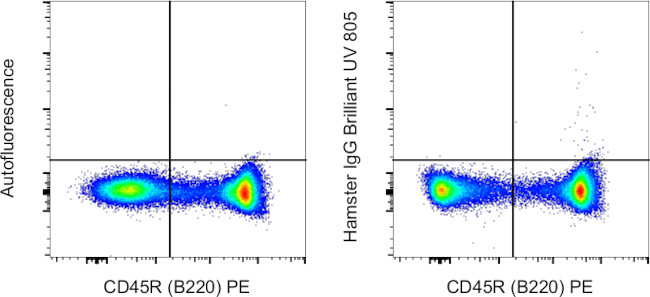Search Thermo Fisher Scientific
Invitrogen
Armenian Hamster IgG Isotype Control (eBio299Arm), Brilliant Ultra Violet™ 805, eBioscience™
FIGURE: 1 / 1
Armenian Hamster IgG Isotype Control (368-4888-81) in Flow

Product Details
368-4888-81
Flow Cytometry (Flow)
Control (Ctrl)
Host/Isotype
Class
Type
Clone
Conjugate
Excitation/Emission Max
Form
Concentration
Purification
Storage buffer
Contains
Storage conditions
Shipping conditions
RRID
Product Specific Information
Description: The eBio299Arm monoclonal antibody is useful as an isotype control immunoglobulin.
Applications Reported: This eBio299Arm antibody has been reported for use in flow cytometric analysis.
Applications Tested: This eBio299Arm antibody has been tested by flow cytometric analysis of mouse splenocytes and normal human peripheral blood cells and should be used at the same concentration as the experimental antibody.
Brilliant Ultra Violet™ 805 (BUV805) is a tandem dye that emits at 797 nm and is intended for use on cytometers equipped with an ultraviolet (355 nm) laser. Please make sure that your instrument is capable of detecting this fluorochrome.
When using two or more Super Bright, Brilliant Violet™, Brilliant Ultra Violet™, or other polymer dye-conjugated antibodies in a staining panel, it is recommended to use Super Bright Complete Staining Buffer (Product # SB-4401) or Brilliant Stain Buffer (Product # 00-4409-75) to minimize any non-specific polymer interactions. Please refer to the datasheet for Super Bright Staining Buffer or Brilliant Stain Buffer for more information.
Light sensitivity: This tandem dye is sensitive to photo-induced oxidation. Please protect this vial and stained samples from light.
Fixation: Samples can be stored in IC Fixation Buffer (Product # 00-8222) (100 µL of cell sample + 100 µL of IC Fixation Buffer) or 1-step Fix/Lyse Solution (Product # 00-5333) for up to 3 days in the dark at 4°C with minimal impact on brightness and FRET efficiency/compensation. Some generalizations regarding fluorophore performance after fixation can be made, but clone specific performance should be determined empirically.
Our internal testing suggests that Brilliant Ultra Violet™ 805 (BUV805) is compatible with short-term methanol-based fixation, but should not be stored in buffers containing methanol for longer than one hour.
Excitation: 355 nm; Emission: 797 nm; Laser: Ultraviolet Laser.
BRILLIANT ULTRA VIOLET™ is a trademark or registered trademark of Becton, Dickinson and Company or its affiliates, and is used under license. Powered by Sirigen™.
Target Information
The isotype of a primary antibody and the application it is being used in can result in background staining. Primary antibody background noise can be caused by binding to Fc receptors on target cells; by non-specific interactions with cellular proteins, carbohydrates, and lipids; or by cell autofluorescence. Isotype control antibodies can act as negative controls to help differentiate non-specific background signal from specific antibody signal because they have no relevant specificity to a target antigen. While isotype controls are most commonly used in flow cytometry, they are useful in other applications such as chromatin immunoprecipitation (ChIP), immunohistochemistry, and gel shifts. Isotype controls should match with the primary antibody species and isotype so that the level of specific staining by the primary antibody may be accurately determined. If using directly labeled primary antibodies, the isotype control works best if conjugated with the same label as the test antibody.
For Research Use Only. Not for use in diagnostic procedures. Not for resale without express authorization.
Bioinformatics
Protein Aliases: IgG; Immunoglobulin G; ImmunoglobulinG

Performance Guarantee
If an Invitrogen™ antibody doesn't perform as described on our website or datasheet,we'll replace the product at no cost to you, or provide you with a credit for a future purchase.*
Learn more
We're here to help
Get expert recommendations for common problems or connect directly with an on staff expert for technical assistance related to applications, equipment and general product use.
Contact tech support

